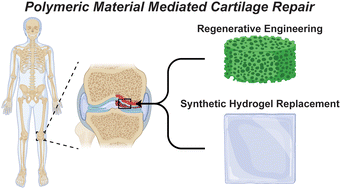Emerging polymeric material strategies for cartilage repair
Abstract
Cartilage is found throughout the body, serving an array of essential functions. Owing to the limited healing capacity of cartilage, damage or degeneration is often permanent and so requires clinical intervention. Established surgical techniques generally rely on biological grafting. However, recent advances in polymeric materials provide an encouraging alternative to overcome limits of auto- and allografts. For regenerative engineering of cartilage, a polymeric scaffold ideally supports and instructs tissue regeneration while also providing mechanical integrity. Scaffolds direct regeneration via chemical and mechanical cues, as well as delivery and support of exogenous cells and bioactive factors. Advanced polymeric scaffolds aim to direct regeneration locally, replicating the heterogeneities of native tissues. Alternatively, new cartilage-mimetic hydrogels have potential to serve as synthetic cartilage replacements. Prepared as multi-network or composite hydrogels, the most promising candidates have simultaneously realized the hydration, mechanical, and tribological properties of native cartilage. Collectively, the recent rise in polymers for cartilage regeneration and replacement proposes a changing paradigm, with a new generation of materials paving the way for improved clinical outcomes.



 Please wait while we load your content...
Please wait while we load your content...